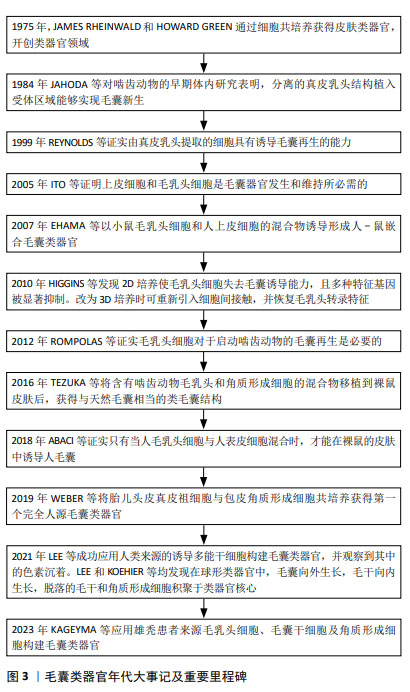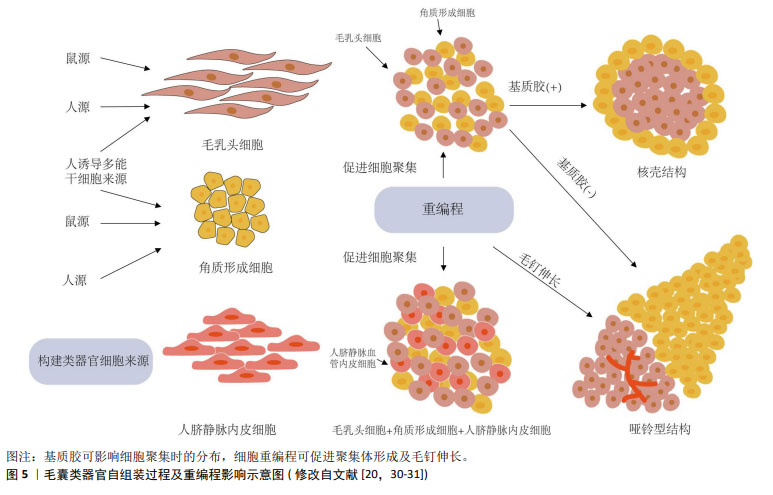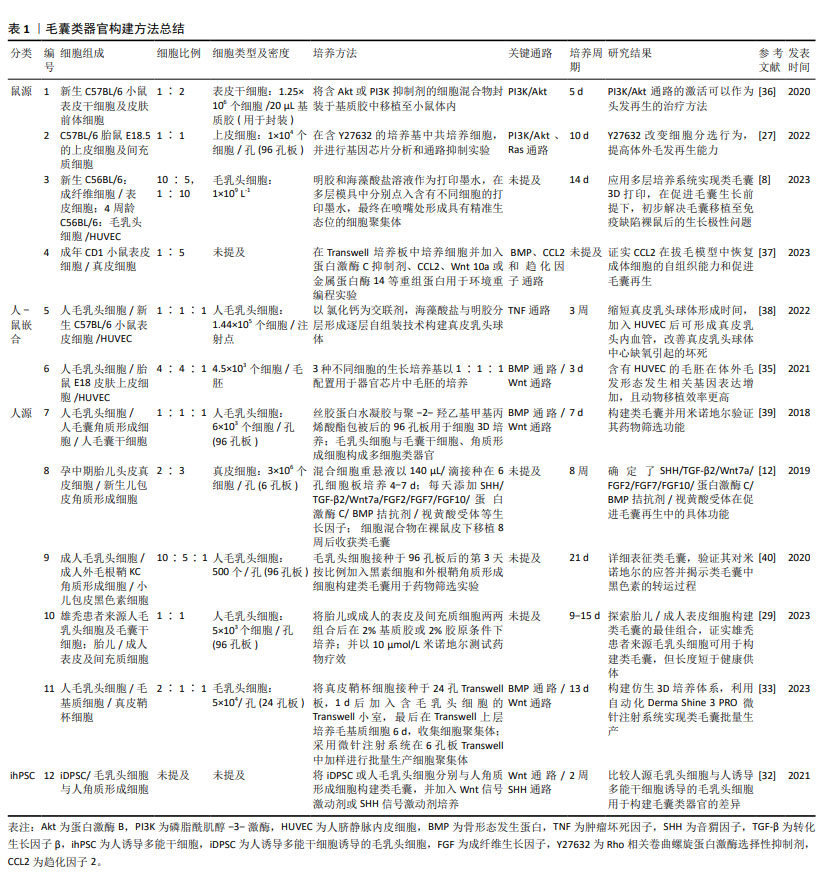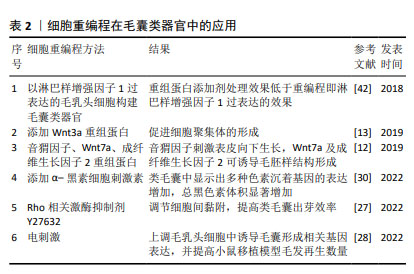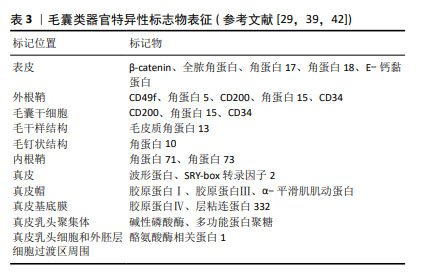[1] LINDNER G, HORLAND R, WAGNER I, et al. De novo formation and ultra-structural characterization of a fiber-producing human hair follicle equivalent in vitro. J Biotechnol. 2011;152(3):108-112.
[2] FOLTZ L, AVABHRATH N, LANCHY JM, et al. Craniofacial chondrogenesis in organoids from human stem cell-derived neural crest cells. iScience. 2024;27(4):109585.
[3] LEE SW, SONG M, WOO DH, et al. Proposal for considerations during human iPSC-derived cardiac organoid generation for cardiotoxicity drug testing. Biomed Pharmacother. 2024;174:116511.
[4] PARK S. Hair Follicle Morphogenesis During Embryogenesis, Neogenesis, and Organogenesis. Front Cell Dev Biol. 2022;10: 933370.
[5] HOSSEINI M, KOEHLER KR, SHAFIEE A. Biofabrication of Human Skin with Its Appendage. Adv Healthc Mater. 2022;11(22):e2201626.
[6] LEE J, VAN DER VALK WH, SERDY SA, et al. Generation and characterization of hair-bearing skin organoids from human pluripotent stem cells. Nat Protoc. 2022;17(5):1266-1305.
[7] WANG M, ZHOU X, ZHOU S, et al. Mechanical force drives the initial mesenchymal-epithelial interaction during skin organoid development. Theranostics. 2023;13(9):2930-2945.
[8] KANG D, LIU Z, QIAN C, et al. 3D bioprinting of a gelatin-alginate hydrogel for tissue-engineered hair follicle regeneration. Acta Biomater. 2023; 165: 19-30.
[9] REYNOLDS AJ, LAWRENCE C, CSERHALMI-FRIEDMAN PB, et al. Trans-gender induction of hair follicles. Nature. 1999;402(6757):33-34.
[10] TEZUKA K, TOYOSHIMA KE, TSUJI T. Hair Follicle Regeneration by Transplantation of a Bioengineered Hair Follicle Germ. Methods Mol Biol. 2016;1453:71-84.
[11] EHAMA R, ISHIMATSU-TSUJI Y, IRIYAMA S, et al. Hair follicle regeneration using grafted rodent and human cells. J Invest Dermatol. 2007;127(9):2106-2115.
[12] WEBER EL, WOOLLEY TE, YEH CY, et al. Self-organizing hair peg-like structures from dissociated skin progenitor cells: New insights for human hair follicle organoid engineering and Turing patterning in an asymmetric morphogenetic field. Exp Dermatol. 2019;28(4):355-366.
[13] SU Y, WEN J, ZHU J, et al. Pre-aggregation of scalp progenitor dermal and epidermal stem cells activates the WNT pathway and promotes hair follicle formation in in vitro and in vivo systems. Stem Cell Res Ther. 2019;10(1):403.
[14] ABE Y, TANAKA N. Roles of the Hedgehog Signaling Pathway in Epidermal and Hair Follicle Development, Homeostasis, and Cancer. J Dev Biol. 2017;5(4):12.
[15] SENNETT R, RENDL M. Mesenchymal-epithelial interactions during hair follicle morphogenesis and cycling. Semin Cell Dev Biol. 2012;23(8): 917-927.
[16] MAO MQ, JING J, MIAO YJ, et al. Epithelial-Mesenchymal Interaction in Hair Regeneration and Skin Wound Healing. Front Med (Lausanne). 2022;9:863786.
[17] MARTEL JL, MIAO JH, BADRI T. Anatomy, Hair Follicle. Treasure Island (FL): StatPearls Publishing,2024.
[18] TOMANN P, PAUS R, MILLAR SE, et al. Lhx2 is a direct NF-κB target gene that promotes primary hair follicle placode down-growth. Development. 2016;143(9):1512-1522.
[19] WATT FM, ESTRACH S, AMBLER CA. Epidermal Notch signalling: differentiation, cancer and adhesion. Curr Opin Cell Biol. 2008;20(2): 171-179.
[20] VATANASHEVANOPAKORN C, SARTYOUNGKUL T. iPSC-based approach for human hair follicle regeneration. Front Cell Dev Biol. 2023;11: 1149050.
[21] FUCHS E. Scratching the surface of skin development. Nature. 2007; 445(7130):834-842.
[22] WALL D, MEAH N, FAGAN N, et al. Advances in hair growth. Fac Rev. 2022;11:1.
[23] LIN X, ZHU L, HE J. Morphogenesis, Growth Cycle and Molecular Regulation of Hair Follicles. Front Cell Dev Biol. 2022;10 899095.
[24] YUE Z, LEI M, PAUS R, et al. The global regulatory logic of organ regeneration: circuitry lessons from skin and its appendages. Biol Rev Camb Philos Soc. 2021;96(6):2573-2583.
[25] YANG M, WENG T, ZHANG W, et al. The Roles of Non-coding RNA in the Development and Regeneration of Hair Follicles: Current Status and Further Perspectives. Front Cell Dev Biol. 2021;9:720879.
[26] HIGGINS CA, CHEN JC, CERISE JE, et al. Microenvironmental reprogramming by three-dimensional culture enables dermal papilla cells to induce de novo human hair-follicle growth. Proc Natl Acad Sci U S A. 2013;110(49):19679-19688.
[27] KAGEYAMA T, ANAKAMA R, TOGASHI H, et al. Impacts of manipulating cell sorting on in vitro hair follicle regeneration. J Biosci Bioeng. 2022; 134(6):534-540.
[28] YAN L, KAGEYAMA T, ZHANG B, et al. Electrical stimulation to human dermal papilla cells for hair regenerative medicine. J Biosci Bioeng. 2022;133(3):281-290.
[29] KAGEYAMA T, MIYATA H, SEO J, et al. In vitro hair follicle growth model for drug testing. Sci Rep. 2023;13(1):4847.
[30] KAGEYAMA T, SHIMIZU A, ANAKAMA R, et al. Reprogramming of three-dimensional microenvironments for in vitro hair follicle induction. Sci Adv. 2022;8(42):eadd4603.
[31] KAGEYAMA T, SEO J, YAN L, et al. Cinnamic acid promotes elongation of hair peg-like sprouting in hair follicle organoids via oxytocin receptor activation. Sci Rep. 2024;14(1):4709.
[32] FUKUYAMA M, TSUKASHIMA A, KIMISHIMA M, et al. Human iPS Cell-Derived Cell Aggregates Exhibited Dermal Papilla Cell Properties in in vitro Three-Dimensional Assemblage Mimicking Hair Follicle Structures. Front Cell Dev Biol. 2021;9:590333.
[33] LIU Z, HUANG J, KANG D, et al. Microenvironmental reprogramming of human dermal papilla cells for hair follicle tissue engineering. Acta Biomater. 2023;165:31-49.
[34] CHOI SH, LEE K, HAN H, et al. Prochondrogenic effect of decellularized extracellular matrix secreted from human induced pluripotent stem cell-derived chondrocytes. Acta Biomater. 2023;167:234-248.
[35] KAGEYAMA T, CHUN Y S, FUKUDA J. Hair follicle germs containing vascular endothelial cells for hair regenerative medicine. Sci Rep. 2021;11:624.
[36] CHEN Y, FAN Z, WANG X, et al. PI3K/Akt signaling pathway is essential for de novo hair follicle regeneration. Stem Cell Res Ther. 2020;11(1): 144.
[37] WU W, ZHOU W, JIANG J, et al. Mechanical stimuli-induced CCL2 restores adult mouse cells to regenerate hair follicles. Mol Ther Nucleic Acids. 2023;32:94-110.
[38] CHEN P, MIAO Y, ZHANG F, et al. Tissue engineering ECM-enriched controllable vascularized human microtissue for hair regenerative medicine using a biomimetic developmental approach. J Adv Res. 2022;38:77-89.
[39] GUPTA A C, CHAWLA S, HEGDE A, et al. Establishment of an in vitro organoid model of dermal papilla of human hair follicle. J Cell Physiol. 2018;233(11):9015-9030.
[40] ATAÇ B, KISS FM, LAM T, et al. The microfollicle: a model of the human hair follicle for in vitro studies. In Vitro Cell Dev Biol Anim. 2020;56(10): 847-858.
[41] CORRÒ C, NOVELLASDEMUNT L, LI V SW. A brief history of organoids. Am J Physiol Cell Physiol. 2020; 319(1): C151-C165.
[42] ABACI HE, COFFMAN A, DOUCET Y, et al. Tissue engineering of human hair follicles using a biomimetic developmental approach. Nat Commun. 2018;9(1):5301.
[43] XIE S, CHEN L, ZHANG M, et al. Self-assembled complete hair follicle organoids by coculture of neonatal mouse epidermal cells and dermal cells in Matrigel. Ann Transl Med. 2022;10(14):767.
[44] KAUR S, KAUR I, RAWAL P, et al. Non-matrigel scaffolds for organoid cultures. Cancer Lett. 2021;504:58-66.
[45] HAN W, HE M, ZHANG Y, et al. Cadherin-dependent adhesion modulated 3D cell-assembly. J Mater Chem B. 2022;10(26):4959-4966.
[46] PALMER JW, KUMAR N, AN L, et al. Molecular heterogeneity of quiescent melanocyte stem cells revealed by single-cell RNA-sequencing. Pigment Cell Melanoma Res. 2024;37(4):480-495.
[47] VAHAV I, VAN DEN BROEK LJ, THON M, et al. Reconstructed human skin shows epidermal invagination towards integrated neopapillae indicating early hair follicle formation in vitro. J Tissue Eng Regen Med. 2020;14(6):761-773.
[48] GONG L, XIAO J, LI X, et al. IL-36α Promoted Wound Induced Hair Follicle Neogenesis via Hair Follicle Stem/Progenitor Cell Proliferation. Front Cell Dev Biol. 2020;8:627.
[49] GAO Y, WANG J, ZHU DC, et al. Dermal macrophage and its potential in inducing hair follicle regeneration. Mol Immunol. 2021;134:25-33.
[50] WANG X, CHEN H, TIAN R, et al. Macrophages induce AKT/β-catenin-dependent Lgr5+ stem cell activation and hair follicle regeneration through TNF. Nat Commun. 2017;8:14091.
[51] CHU SY, CHOU CH, HUANG HD, et al. Mechanical stretch induces hair regeneration through the alternative activation of macrophages. Nat Commun. 2019;10(1):1524.
[52] WANG ECE, DAI Z, FERRANTE AW, et al. A Subset of TREM2+ Dermal Macrophages Secretes Oncostatin M to Maintain Hair Follicle Stem Cell Quiescence and Inhibit Hair Growth. Cell Stem Cell. 2019;24(4): 654-669.e6.
[53] 杜丽娟.基于器官原基组织工程原理构建单位毛囊微组织的实验研究[D].广州:南方医科大学,2023.
[54] GAN Z, QIN X, LIU H, et al. Recent advances in defined hydrogels in organoid research. Bioact Mater. 2023;28:386-401.
[55] VALDOZ JC, JOHNSON BC, JACOBS DJ, et al. The ECM: To Scaffold, or Not to Scaffold, That Is the Question. Int J Mol Sci. 2021;22(23): 12690.
[56] ATWOOD SX, PLIKUS MV. Fostering a healthy culture: Biological relevance of in vitro and ex vivo skin models. Exp Dermatol. 2021; 30(3):298-303.
[57] SCHWEIZER J, LANGBEIN L, ROGERS MA, et al. Hair follicle-specific keratins and their diseases. Exp Cell Res. 2007;313(10):2010-2020.
[58] KAO WWY. Keratin expression by corneal and limbal stem cells during development. Exp Eye Res. 2020;200:108206.
[59] SILVA LMA, HSIEH R, LOURENÇO SV, et al. Immunostaining study of cytokeratins in human hair follicle development. An Bras Dermatol. 2020;95(3):278-282.
[60] TOPOUZI H, LOGAN NJ, WILLIAMS G, et al. 2017Methods for the isolation and 3D culture of dermal papilla cells from human hair follicles. Exp Dermatol. 2017;26(6):491-496.
[61] OHYAMA M. Use of human intra-tissue stem/progenitor cells and induced pluripotent stem cells for hair follicle regeneration. Inflamm Regen. 2019;39:4.
[62] KRETZSCHMAR K, BOONEKAMP KE, BLEIJS M, et al. Troy/Tnfrsf19 marks epidermal cells that govern interfollicular epidermal renewal and cornification. Stem Cell Reports. 2021;16(9):2379-2394.
[63] LEI M, LIN SJ, CHUONG CM. Editorial: Hair Follicle Stem Cell Regeneration in Aging. Front Cell Dev Biol. 2021;9:799268.
[64] XIAO X, GAO Y, YAN L, et al. M1 polarization of macrophages promotes stress-induced hair loss via interleukin-18 and interleukin-1β. J Cell Physiol. 2024;239(4):e31181.
[65] ALLMEROTH K, KIM CS, ANNIBAL A, et al. N1-acetylspermidine is a determinant of hair follicle stem cell fate. J Cell Sci. 2021;134(9): jcs252767.
[66] KAGEYAMA T, YOSHIMURA C, MYASNIKOVA D, et al. Spontaneous hair follicle germ (HFG) formation in vitro, enabling the large-scale production of HFGs for regenerative medicine. Biomaterials. 2018;154: 291-300.
[67] JEONG S, NA Y, NAM HM, et al. Skin-on-a-chip strategies for human hair follicle regeneration. Exp Dermatol. 2023;32(1):13-23.
|
